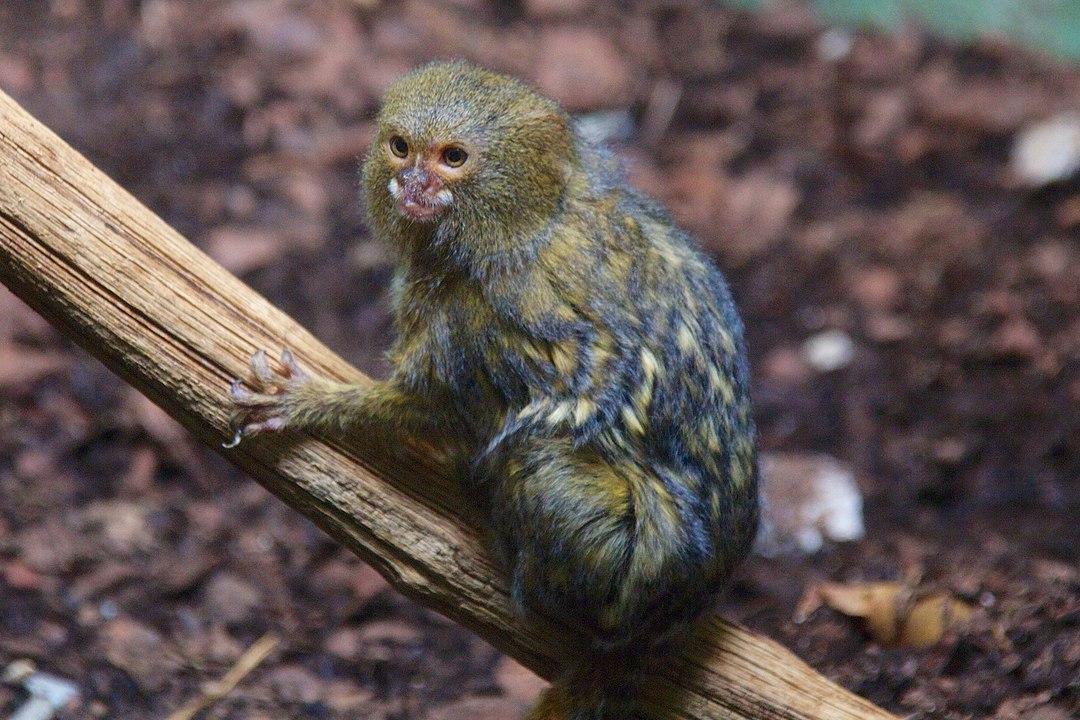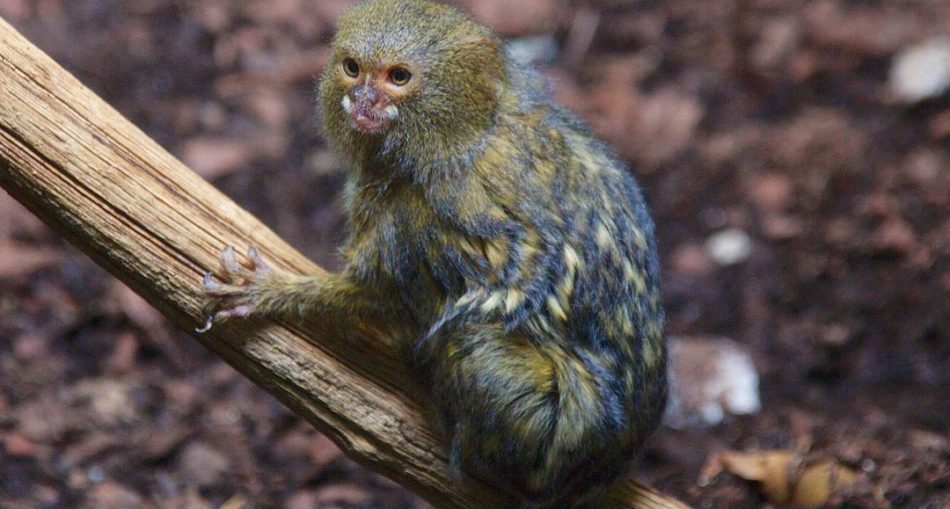The Pygmy Marmoset is the smallest monkey in the New World, known for its familial bond and tree sap-eating habits. The pygmy stands just under five inches tall. They are also known as they finger monkeys as they can fit quite comfortably in your hands. Pygmy Marmosets belong to a genus called Cebuella. There are two species of marmosets, the Western Pygmy Marmoset (Cebuella pygmaea) and Eastern Pygmy Marmoset (Cebuella niveiventris). However, there are not many noticeable differences between them except for a slight variation in their colouring. The Pygmy Marmoset is native to South America in countries like Bolivia, Brazil, Colombia, Ecuador, Guyana, and Peru. Read on to find out more interesting facts about the tiniest monkey in the world!

The Pygmy Marmoset – Photo By Photograph by Mike Peel (www.mikepeel.net)., CC BY-SA 4.0, https://commons.wikimedia.org/w/index.php?curid=33767032
Features Of The Pygmy Marmoset
- Sexual dimorphism: Both male and female share similar characteristics, the only difference is that the females generally weigh more.
- Fur: The fur of the Pygmy Marmoset is a silky blend of tawny, an orange-brownish colour, grey and black. The underparts are of a similar combination. On either side of their faces, these primates have distinguishable tufts of fur, which also conceals their ears.
- Weight: The adult Pygmy Marmoset weights an average of one hundred (100) grams, which is no surprise as they are tiny.
- Length: This primate is among the smallest known and is the smallest known true monkey. The length of its body ranges from the smallest size of one hundred seventeen (117) to one hundred fifteen (152) mm.
- Tail & Nose: Tails are typically longer, almost double the length of their bodies. The length varies from one hundred seventy-two (172) to two hundred twenty-nine (229) mm. Black rings can be found lengthwise along the tail. The Pygmy Marmoset has one straight, white line in the middle of its nose.
- Fingers: Their hands are very similar to squirrels. With the except of their big toes that has nails, the rest of their fingers and toe end in sharp, black claws which help them in climbing.
- Young: Baby Pygmy Marmosets have a sheer yellow coat and grey heads. Adults markings develop as they age.
Scientific Classification Of The White-faced Saki
The Pygmy Marmoset – Cebuella [Scientific name]
- Kingdom: Animalia
- Phylum: Chordata
- Class: Mammalia
- Order: Primates
- Suborder: Haplorhini
- Infraorder: Simiiformes
- Family: Callitrichidae
- Genus: Cebuella
Habitat of the Pygmy Marmoset
The Pygmy Marmoset lives in evergreen rainforests, in the west of the Amazon Basin. Their homes can be found close to waterways, in trees or thickets of bamboo.
Reproduction Of The Pygmy Marm
In each troop of Pygmy Marmoset, there is one dominant female who typically produces the offprings. The female gives birth once or twice a year and is a non-seasonal breeder. When she is ready to mate, a chemical creation is released from genitals, anus and chest, to inform males that she is ready to reproduce. Pregnancies last for about four and a half months and usually produce twins and occasionally, triplets. Babies are the size of a human’s thumb and weigh about fourteen (14) grams. The Pygmy Marmoset is able to breed three (3) weeks after her first pregnancy. After birth, the care of the infants is shared in the group.
Males have the responsibility of taking care of the babies, even helping in their birth. Older siblings take care of the infants who require a lot of attention. The most suitable number of caregivers is five (5) which relieves the burden from one individual. Pygmy Marmosets are weaned after about three (3) months. They are sexually mature after one and a half years and reach adulthood after two years. Marmosets remain in the troop for about two births. learning parenting skills before moving on and starting their own families.
Pgymy Marmoset Groups & Travel:
Pygmy Marmosets live in groups about two to nine (2-9) members, with one or two adult males and females, and one female who is responsible for reproducing and her babies. While the range of Pygmy Marmoset groups is about one (1) acre, they usually feed on one or two trees simultaneously. When the trees are exhausted, the group changes their home range.
Diet Of The Pygmy Marmoset
The Pygmy Marmoset is an omnivorous creature whose diet consists of special tree sap, small insects, like butterflies who frequent the sap holes in these trees but also eats fruits and nectar. However, its preferred food is tree gum. With its well-adapted teeth, this marmoset makes holes through the bark of trees and vine which produces the sap. With the use of its tongue, the mammal licks the sap that accumulates in the holes.
Facts About the Pygmy Marmoset
- The Pygmy Marmoset is able to rotate its head up to 180 degrees.
- A large cecum allows for longer periods of digestion which allows sufficient time for for the gum to be broken down.
- Their feeding or gum holes are often raided by brown-mantled tamarins.
- Pygmy Marmosets have specialized claws, like insects tegulae which supports their bodies while foraging in trees.
- Males and female marmosets in groups can even postpone their reproduction to take care of the offspring of others
The Pygmy Marmoset In Guyana
The Pygmy Marmoset is the among smallest primates in the world. They tend to live in groups and all of the members lend a hand in taking care of the young. Unlike most males in the animal kingdom, most male Pygmy Marmosets, play an active role in taking care of the young. Some people keep them as pets, while others insist they belong in their native habitat. However, if you do have a pet Pygmy Marmoset, remember to get some of its favourite food-the tree sap!
Article References
- https://www.livescience.com/58447-marmoset-facts.html
- https://www.neprimateconservancy.org/pygmy-marmoset.html
- https://en.wikipedia.org/wiki/Pygmy_marmoset
- http://pin.primate.wisc.edu/factsheets/entry/pygmy_marmoset
- https://animals.sandiegozoo.org/animals/pygmy-marmoset#:~:text=Pygmy%20marmosets%20live%20in%20the,hiding%20places%20among%20the%20plants.







